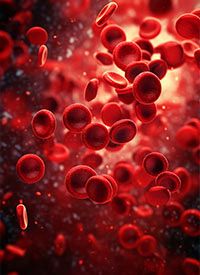News
Article
First-Line Orelabrutinib Plus FCG Generates Rapid Molecule Remissions in CLL
Author(s):
Key Takeaways
- Orelabrutinib plus FCG achieved 100% undetectable MRD in bone marrow and peripheral blood after 12 cycles.
- The complete response/CR with incomplete count recovery rate after 12 cycles was 80%.
Orelabrutinib plus FCG led to undetectable MRD in all patients with untreated chronic lymphocytic leukemia who completed 12 cycles of therapy
Orelabrutinib Plus FCG Generates Rapid Molecule Remissions in CLL

Orelabrutinib in combination with fludarabine, cyclophosphamide, and obinutuzumab (Gazyva; FCG) produced rapid molecular remissions that deepened over time in younger, fit patients with previously untreated chronic lymphocytic leukemia (CLL), including those with high-risk genetic features, according to findings from the investigator-initiated phase 2 CWCLL-001 study (NCT05322733) presented at the 2024 EHA Congress.1
Data showed that among patients who completed 12 cycles of treatment (n = 15), the rates of undetectable minimal residual disease (MRD) in the bone marrow and peripheral blood were both 100%. The complete response (CR)/CR with incomplete count recovery (CRi) rate after cycle 12 was 80.0%. Notably, all patients who completed 12 cycles of therapy discontinued orelabrutinib after cycle 12 after achieving undetectable MRD in the bone marrow.
“The orelabrutinib plus FCG regimen leads to a rapid and deep molecular remission with a manageable safety profile in previously untreated [patients with] CLL, including those with unfavorable characteristics,” lead study author Huayuan Zhu, MD, of the Department of Hematology, Lymphoma Center, at Jiangsu Province Hospital, the first affiliated Hospital of Nanjing Medical University in China, and colleagues, wrote in a poster presentation.
The cwCLL-001 trial was a multicenter, open-label, nonrandomized study that investigated orelabrutinib—a novel, second-generation, highly selective irreversible BTK inhibitor— in combination with FCG in patients at least 18 years of age with previously untreated CLL or small lymphocytic lymphoma. Notably, there was no restriction regarding the presence of 17p deletions, TP53 aberrations, and/or unmutated IGHV at baseline. Patients were required to have an ECOG performance status of 0 to 2; a cumulative disease score of 6 or less; and a creatinine clearance of at least 70 mL/min.
All patients initially received a 7-day lead-in with oral orelabrutinib at 150 mg daily, followed by the obinutuzumab in combination with FCG for cycles 1 to 3. Those who achieved undetectable MRD in the bone marrow received orelabrutinib plus obinutuzumab in cycles 4 to 6; those with detectable MRD continued orelabrutinib plus FCG. In cycles 7 to 12, orelabrutinib monotherapy was given to patients achieving undetectable MRD in the bone marrow; those with detectable MRD were given orelabrutinib plus obinutuzumab. From cycles 13 to 24, patients with undetectable MRD in the bone marrow discontinued all treatment; those with detectable MRD received orelabrutinib alone.1,2
The primary end point was the rate of undetectable MRD in the bone marrow after 6 cycles of treatment. Secondary end points encompassed undetectable MRD rates in bone marrow and peripheral blood at other time points; best overall response rate; CR rate; progression-free survival; duration of response, overall survival, and safety.1
From May 2022 through June 2023, investigators enrolled 25 patients with a median age of 49 years (range, 23-62). Notably, 56.5% had unmutated IGHV (n = 13/23), 16.0% harbored TP53 mutations and/or 17p deletions, and 24.0% had 11q deletions. The majority of patients were male (60.0%), had an ECOG performance status of 0 (80.0%), did not have bulky disease (76.0%), and did not have a high CLL international prognostic index score (55.5%).
At the data cutoff of February 6, 2024, 24 patients had completed 3 cycles of orelabrutinib plus FCG, and 22 patients finished 6 cycles of treatment. Notably, 2 patients were off study treatment due to willingness, and 1 patient died after cycle 3 due to COVID-19.
Additional data showed that after cycle 3, the peripheral blood undetectable MRD rate, bone marrow undetectable MRD rate, and CR/CRi rate were 70.8%, 56.6%, and 31.8%, respectively. After cycle 6, these respective rates were 95.2%, 86.4%, and 59.1%.
Regarding safety, all patients experienced at least one treatment-emergent adverse effect (AE). Zhu and colleagues reported that most AEs were mild and tolerable. The most frequent any-grade AEs reported in at least 10% of patients included neutropenia, leukopenia, and thrombocytopenia.
References
- Zhu H, Miao Y, Qin S, et al. Orelabrutinib, fludarabine, cyclophosphamide, and obinutuzumab (OFCG) for first-line treatment of chronic lymphocytic leukemia:multicenter, investigator-initiated study. Presented at: 2024 EHA Congress; June 13-16, 2024; Madrid, Spain. Abstract P680.
- Orelabrutinib and obinutuzumab plus FC regimen in treating newly diagnosed CLL/SLL. ClinicalTrials.gov. Updated April 19, 2022. Accessed July 3, 2024. https://clinicaltrials.gov/study/NCT05322733








